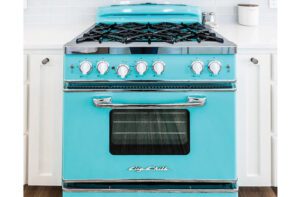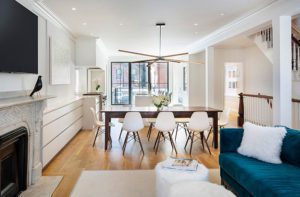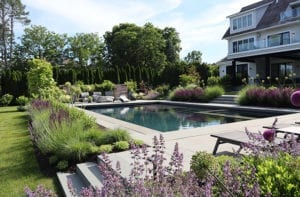Steven Favreau Transforms a Boston Rental
May 17, 2017
A Boston designer’s temporary abode proves that renting an apartment doesn’t have to mean sacrificing self-expression.
Text by Lisa H. Speidel Photography by Greg Premru
When interior designer Steven Favreau decided to lease a one-bedroom apartment in Boston, he enlisted a real estate agent, who shot back an email with eight potential properties. Only one interested Favreau: “It was always my dream to have a post-and-beam warehouse loft,” he says.
He visited the building, a former shoe factory retrofitted into condos in South Boston’s Fort Point Channel area, and promptly fell in love. “I went to the center of the space, did a little twirl (incidentally, the last time he lived in Boston was in the 1980s, when he was a musical theater and dance major at the Boston Conservatory), and said ‘I’ll take it.’ ”
Favreau, who splits his time between Boston and San Francisco, has leased countless apartments over the last two decades. “Every time I rented,” he says, “I would transform a place as much as I possibly could.”
As a tenant, Favreau approaches design differently. He takes cost into greater consideration, and he’s aware that when he moves out, the onus is on him to return the space to its original state. “I pull from my theater background,” he says. “It’s a lot of smoke and mirrors.”
So it was with this in mind that he set out to “pimp this apartment.” If that sounds like a reality show, it’s not far off—Favreau was on HGTV’s White Room Challenge. “Here I am living my TV life all over again, with this big, fabulous white space screaming to be transformed,” he says with a laugh.
He incorporated many of his signature design principles. Chief among them: mixing the old with the new. In his foyer, for instance, an industrial door meets an antique Tiffany clock, which meets a modern take on a Louis XV chair.
Another Favreau signature, a fur rug (“There is fur in every job I do!”) brings texture and warmth. And a $100 black-and-white mural of the Flatiron District in New York City speaks to the designer’s ingenuity and thriftiness. “I’m known for wallpaper in my work, but I couldn’t do that here,” he says. “I had to get creative.” In this case, to mimic wallpaper and add depth, he placed two Ikea cabinets side-by-side and wrapped and stapled the mural to their backs. The cabinets delineate the foyer from the sleeping quarters and provide closet space.
In the bedroom, he used another mural, this time installing a seven-by-ten-foot rendering of an antique library behind the bed. Blue-plaid felted-wool drapes create a foreground and background, adding to the illusion that the space goes on forever. Ever cognizant of cost, Favreau scored the mural online for a song, and the Robert Allen drapes were left over from a Junior League show house he recently completed. A collage of handheld mirrors the designer has amassed over two decades hangs on one wall, again a nice textural and cost-effective alternative to wallpaper.
Just as the mirrors reflect a personal journey, Favreau used existing shelves in the living room to showcase some of his favorite mementoes, from pottery to pictures. “It’s the story of my life on shelves,” he says. He then got creative, framing the shelves with drapes (“You don’t have to have a window to hang a drape,” he says) and subbing out standard light fixtures for two cloud-like fixtures from Ikea. He made the coffee table out of plywood, attaching the fabric with a staple gun and wrapping the legs in marine rope. The polished-chrome birdcage chairs came courtesy of the design show house. “They’re the most uncomfortable things you’ve ever sat in, but they certainly look fabulous,” he jokes.
In the dining room, Favreau continued his propensity to mix and match periods, styles, textures, and price points. A hand-carved wooden Indian mirror, a stainless-steel cart, a Chinese ginger jar, and two original oil paintings all play nicely together in the far corner. Getting crafty, he repurposed a floor-to-ceiling swath of blue fabric that matches the throw on the bed and stapled it to the wall, seamlessly tying in a design element from across the loft.
Not only does the designer swear by mixing and matching, his motto is to be fearless about it. Nowhere is this bold approach more apparent that in the kitchen, where Favreau gave the utilitarian cabinets a new look with—wait for it—blue electrician’s tape. “I needed to add something exciting,” he says. “I didn’t measure, I didn’t lay it out, I just did it.”
And therein lies the inherent beauty of a rental: take chances; it’s temporary.
Share
![NEH-Logo_Black[1] NEH-Logo_Black[1]](https://www.nehomemag.com/wp-content/uploads/2022/08/NEH-Logo_Black1-300x162.jpg)















You must be logged in to post a comment.